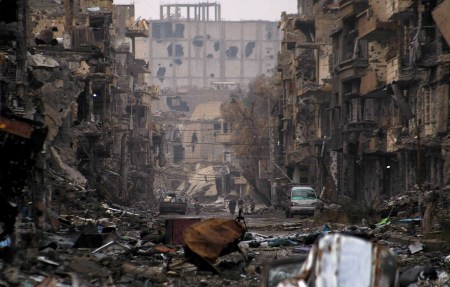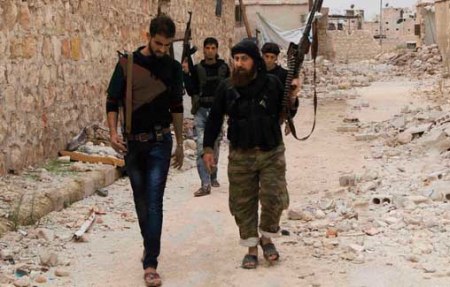Russia tries to restart a peace process in Syria that would include meetings between government officials and members of the opposition. Syrian president Bashar al-Assad expressed his support for Moscow’s initiative after meeting with Russia’s Deputy Foreign Minister Mikhail Bogdanov. “Russia has always been on the side of the Syrian people and given proof that it backs the people’s right to decide its own fate,” al-Assad said and added, that “Russia respects the sovereignty of states and international law.”
The Russian foreign ministry reported that al-Assad and Bogdanov also discussed “consolidating efforts in the fight against the Islamic State group and other terrorist organizations.”
Already in November, Russia held separate meetings in Moscow with a top opposition leader, Ahmad Moaz al-Khatib, and with a delegation headed by Syrian Foreign Minister Walid Muallem. Al-Khatib subsequently called for direct talks with al-Assad’s government to try to end the war.
Differences between Jaysh al-Islam and Jabhat al-Nusra have emerged, revealing the existence of a huge tunnel linking the Barzeh and Harasta neighborhoods of Damascus. The tunnel had been dug at considerable cost in order to transfer supplies to the fighters in Ghouta (an area of northeast Damascus countryside) and break the siege imposed by the Syrian army on the Ghouta neighborhood.
Although the location and route of the tunnel remain unknown, its existence was uncovered when Jabhat al-Nusra’s emir in the region arrested a leader in Jaish al-Islam who was tasked with overseeing the tunnel. Both movements exchanged accusations, each side accusing the other of trying to monopolize the tunnel to serve its own interests.
It is noteworthy that the Barza neighborhood has been one that was covered by a settlement agreement between the militants and the Syrian army for several months now. Uncovering this tunnel might affect this settlement, especially if it is proven that some factions which signed the settlement had kept the tunnel secret or participated in using it.
Jabhat al-Nusra’s attempt to take over the tunnel indicates that it has a plan to carry out acts in East Ghouta. This is especially likely as information has been circulating about rising disputes between the movement and Jaish al-Islam. Moreover, Jabhat al-Nusra is worried about the increasing power of IS (Islamic State) in some regions in the Damascus suburbs (for instance Rif Dimashq east of Damascus), where IS announced forming a camp to train “the caliphate cadets” in south Damascus.
In the same context, IS militants managed to take over the Bir al-Qasab area of the Damascus suburbs following violent clashes with Jaish al-Islam that went on for several days.
Bir al-Qasab is a strategic location for East Ghouta as it constitutes a supply line out to the Jordanian border. Bir al-Qasab is also important for Daraa, as it is the gateway to Daraa due to its proximity to al-Lajat region. It is no longer a secret that IS intends to enter Daraa.
A local source in Al-Hajar al-Aswad city informed the press that Jaish al-Islam’s campaign against IS in the past few months did not destroy the latter. This is contrary to what what Zahran Aloush (head of Jaish al-Islam) and his media platforms recently declared. IS militants hid and disappeared, waiting for the right moment, which seems to have come now.
The Syrian army has kept control of the Deir ez-Zor Airport after succeeding in thwarting an attack by IS on the military airport. Although clashes are still ongoing in the surrounding areas, they have lessened to a large degree.
IS fighters quickly retreated after their attack on the airport failed, withdrawing to the outskirts of surrounding villages. The Syrian army launched intensive airstrikes on IS strongholds in the villages of al-Jafra, al-Hawija and Marihiyak in order to further secure the airport area and prevent fighters from having a second opportunity at getting close to its walls.
On December 7 airstrikes also hit Hawija Saker, which witnessed violent clashes between the two sides, leading to the death of a number of IS fighters. Raids also targeted neighborhoods inside the city of Deir ez-Zor — in the al-Omal and al-Matar neighborhoods as well as the gas station near Ghassan Abboud roundabout, which led to the outbreak of fire.
During the past few days, the military clashes raging in the areas surrounding the military airport of Deir ez-Zor have led to the death of dozens of IS fighters, which included Arabs and foreigners, but many were from the countryside of Deir ez-Zor, particularly from the villages of Bou Lel, Bou Omar, and Mohsen.
This prompted locals to accuse IS of sending the young men of these villages to their demise. Many people suspect, that mobilizing young men to join IS fights is part of an ongoing massacre against the people of Deir ez-Zor, which has been underway since it first controlled the city a few months ago. They believe that the objective of IS is clearly to get rid of the city’s young men who are capable of fighting and thus ensuring that no rebellion can rise against it, as happened with the Sheaitat clan in eastern Syria.
Suleiman Issa al-Kahilat (aka Abu Hajar Al-Sheati), who is the brother of Abu Ali Al-Sheati — one of the first people to pledge allegiance to IS in the city at the beginning of the year — was among those who perished in the clashes.
Meanwhile, in the countryside around Aleppo, clashes between Jabhat al-Nusra and other armed factions have been intensifying.
The tensions in the suburbs of Idlib persist between Jabhat al-Nusra and the Hazm Movement, as the repercussions of the arrest of the leader of the movement, Mashhour al-Tawil, are still unfolding. Recently, the movement issued a statement threatening to target hundreds of Jabhat al-Nusra’s leaders and militants if their leader was not released.
However, the authenticity of the statement was dubious but facts indicate that things are heading toward escalation. This is especially the case since Jabhat al-Nusra has insisted on destroying any allies of Jamal Maarouf in the suburbs of Idlib. They are paving the way for turning the region into an emirate, even though there is no official declaration of such a thing. The tensions worsened yesterday in the Idlib suburbs when news circulated about the disappearance of a member from “the Sharia Committee of al-Sham Legions,” Sheikh Abdullah Rahal, and Jabhat al-Nusra was accused of abducting him.
Edward Drake, an Aleppo based journalist who was initially supportive of the rebels but has become disillusioned over time, told the story of Ahmed, a young farm laborer from a village near the town of Azaz, bordering Turkey, as a striking example of how the Syrian revolution brought out the worst in people even before it had the chance to further ideals of pluralism, tolerance, and democratic civil rule.
Drake writes:
When civil unrest first broke out and started leaping from place to place in Syria like an infectious fever, Ahmed saw his first opportunity. He wanted to join the Syrian security services — Amn el Dawleh in Aleppo city — which had just recently opened to fresh recruits. Ahmed was delighted: “They will give me a gun and a nice salary,” he said, “I will have power and be feared in my village.”
Ahmed was eventually persuaded not to go through with it, as a new and better deal soon came to town: the rebel militias. Arms flowed into the northern Aleppo countryside through the old smuggling routes that had served the people of Azaz for decades and new local militias started appearing everywhere in early 2012. Ahmed quickly joined what would become the “Fateh” brigades of Azaz, a largely criminal outfit geared toward extortion, theft and abuse of both local people and passers-through. They were involved initially in the fighting that ousted the small forces the Syrian regime had sent to restore its authority in the area, but after that small victory, they rested on their laurels and started to reap the fruits of their labors.
Ahmed became an abusive mini-tyrant. His gun and militia had given him power, and it went to his head. He started going after people who he thought had wronged him when he was an impoverished laborer. He shot and killed one of them after deliberately provoking him, a middle-aged man who had once beaten Ahmed for leering at and harassing local girls.
Ahmed is by no means unique. There were many like him who quickly corrupted the revolution and helped turn it into a destructive force of wanton violence, revenge, and crime.
But this warlord utopia wouldn’t last long. IS and its former rebel allies turned on one another and split from Jabhat al-Nusra in Syria.
IS came to Azaz and took it with a handful of fighters in September 2013. They came to town and gave an ultimatum to rebel groups there, going from one headquarters to another with the same message: “You have two days to leave Azaz. If you resist, you will all be killed. If you stay, you must join us and pledge allegiance to our leader Abu Bakr al-Baghdadi.”
Most of them packed up their gear and were gone the next day. Like scuttling rats, they left for the Bab el Salameh crossing. IS came in unopposed the day after, and did a victory lap around the town in their pickup trucks. Some stayed, including Ahmed, who thought this would be an even better opportunity to join a stronger group and get more power and plunder.
This would prove to be a tragic miscalculation. IS knew about Ahmed and people like him. They had not much use for criminal layabouts. He was cannon fodder, sent straight to the front lines in Deir ez-Zor to fight against local groups and Jabhat al-Nusra at the time when IS was trying to establish its caliphate. Instead of the easy life he hoped for, he was soon killed and his remains sent home to be buried in his village a couple of days later.
On November 28 President Bashar al-Assad gave an interview to Paris Match and he countered the often offensive and disrespectful questions and allegations of the interviewer brilliantly.





Keine Kommentare:
Kommentar veröffentlichen